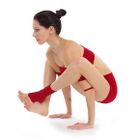Religion:Mālāsana
thumb|right|200px|Mālāsana viewed from the front.
Mālāsana, or malasana, is a term for various squatted āsanas.[1][2] The term is being used in various western transliterations, and may refer to various asanas, all involving a squatted position.
In the West, the term malasana is commonly used for the "regular squat pose", also called upavesasana,[3] in which the hand palms are folded together in the so-called namaskar mudra in front of the chest, and the feet are set wider apart, which resembles the traditional defecating position.
Traditionally mālāsana, or "Garland Pose", is used for a different squatting pose with the feet together and the back rounded with multiple hand placement variations.[4] When the hands are bound around the back this pose is also referred to as kanchyasana ("golden belt pose").[2]
The term mālāsana is also used in the Sritattvanidhi to describe the bhujapidasana, the "shoulder press", in which the hands are placed at the bottom, the body balancing on the hands, and the legs resting on the shoulders.[5]
Etymology
Mālāsana is a compound of two Sanskrit terms, mālā meaning garland and āsana meaning posture.
- Mālāsana, Sanskrit: मालासन ([mɑːlɑːsənə]), a compound of mālā and āsana, which means "Garland Pose".[6] According to Iyengar, the name mālāsana derives from the arms "hanging from the neck like a garland."[6] The term mālāsana has also been used to refer to bhujapidasana,[5] an asana in which the legs seem to be hanging from the neck with the appearance of a necklace.
Description
The term mālāsana may refer to four different asanas:[1][5][6][2]
Upavesasana
The term malasana is commonly used in the West for the "regular squat pose," also called upaveśāsana,[3] in which the handpalms are folded together in namaskar mudra (prayer posture) in front of the chest, and the feet are set wider apart.
This asana is a squat with heels flat on the floor and hip-width apart (or slightly wider if necessary), toes pointing out on a diagonal. The torso is brought forward between the thighs, elbows are braced against the inside of the knees, and the hands pressed together in front of the chest in Añjali Mudrā.
The Yoga Journal says the malasana stretches the ankles, groins and back, tones the belly. It also cautions about using the asana when there are lower back or knee injuries.[web 2]
Mālāsana I/Kanchyasana
In the first variant, the feet are together with the arms wrapped around the back, while the chin touches the floor.[7] When the arms are bound behind this asana is also called kanchyasana ("golden belt pose").[2]
Mālāsana II
In the second variant, the hands wrap around the heels, and touches the floor with the chin.[4][note 1]
Bhujapidasana
The Sritattvanidhi, a 19th-century book on a number of subjects including asanas,[note 2] gives a different picture for an āsana called mālāsana at plate no.44.[5] In this picture, the palms are placed flat on the floor, arm stretched upright, and the whole body balancing on the hands, while the legs are held close to the body, with the heels hanging down from a position close to the shoulders. This asana is also known as bhujapidasana,[9] the "shoulder press."[8][note 3] The mālāsana can be used as a preparation for the bhujapidasana.
See also
- List of asanas
Notes
- ↑ Iyengar mentions this as variant II.[4]
- ↑ According to Sjoman, the Sritattvanidhi may have been written by Mummadi Krishnaraja Wodeyar (1794–1868).[8] It contains pictures of asanas linked together in series and is considered one of the oldest examples of vinyasa.[8]
- ↑ In this position, the arms are indeed "hanging from the neck like a garland,"[6] in contrast to Iyengar's squatting mālāsana and upavesasana.
References
- ↑ 1.0 1.1 Iyengar 1979, p. 261-267.
- ↑ 2.0 2.1 2.2 2.3 Ramaswami & Krishnamacharya 2005, p. 28.
- ↑ 3.0 3.1 Kaminoff & Kaminoff 2013.
- ↑ 4.0 4.1 4.2 Iyengar 1979, p. 266.
- ↑ 5.0 5.1 5.2 5.3 Sjoman 1999, p. 27.
- ↑ 6.0 6.1 6.2 6.3 Iyengar 1979, p. 267.
- ↑ Iyengar 1979, p. 262-266.
- ↑ 8.0 8.1 8.2 Sjoman 1999, p. 40.
- ↑ Iyengar 1979, p. 280-282.
Sources
- Gavalas, Elaine (2003), The Yoga Minibook for Longevity: A Specialized Program for a Healthier, Vital You, Simon & Schuster, ISBN 978-0-7432-2699-8
- Iyengar, B.K. (1979), Light on Yoga, Unwin Paperbacks
- Kaminoff, Leslie; Kaminoff, Matthew (2013), Yoga-Anatomie: Ihr Begleiter durch die Asanas, Bewegungen und Atemtechniken, Riva Verlag
- Ramaswami, Srivatsa; Krishnamacharya, T. (2005), The complete book of vinyasa yoga: an authoritative presentation, based on 30 years of direct study under the legendary yoga teacher Krishnamacharya, Da Capo Press, ISBN 978-1-56924-402-9
- Sjoman, N.E. (1999), The Yoga Tradition of the Mysore Palace, Abhinav Publications
Further reading
- Iyengar, B. K. S. (2005), Illustrated Light On Yoga, HarperCollins, ISBN 978-81-7223-606-9
- Saraswati, Swami Satyananda (2003), Asana Pranayama Mudra Bandha, Nesma Books India, ISBN 978-81-86336-14-4
- Saraswati, Swami Satyananda (2004), A Systematic Course in the Ancient Tantric Techniques of Yoga and Kriya, Nesma Books India, ISBN 978-81-85787-08-4
External links





